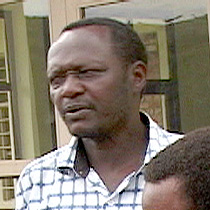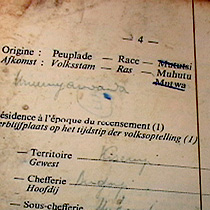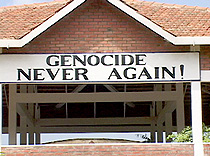2007年VOA标准英语-Memorial Honors Victims of 1994 Rwandan Genocid
搜索关注在线英语听力室公众号:tingroom,领取免费英语资料大礼包。
(单词翻译)
By Cathy MajtenyiMurambi, Rwanda
12 July 2007
Rwanda's rolling green countryside and laid-back city life paint a picture of peace and tranquility. But beneath the calm surface, the people of this African Great Lakes country are still struggling to come to terms with the traumas1 of the genocide that took place here 13 years ago. Cathy Majtenyi visited Rwanda recently and files this report on the importance of remembering the tragedy. (Warning: some of the images in the video are graphic).
 |
| Francis Rusanganwa, a curator at the Murambi Genocide Memorial site |
On April 21, 1994 at this former technical college, Hutu militia2 and Hutu government soldiers shot or hacked3 to death about 50,000 Tutsis.
Rusanganwa's family members are among the bodies that are preserved in lime.
"Every day I open the doors. I show to the visitors what happened, I explain the history. I remember my family, who has been killed here. I am very, very -- everyday -- very shocked. I'm sad. I'm frustrated," says Rusanganwa.
The roots of the 1994 genocide date back to the late 1880s during colonialism.
 |
| The old identity card has a Race category |
In the months leading up to the genocide, the Hutu government carried out massive print and radio propaganda campaigns against the minority Tutsis, urging Hutus to rise up and kill the Tutsis.
The genocide began on April 6th, 1994, following the assassination4 of President Juvenal Habyarimana.
 |
| Memorials exist to make sure that genocide is not repeated |
Thirteen years later, genocide memorial sites dot the countryside, such as where Rusanganwa and others make it their personal mission to ensure that the world does not forget the events of 1994 and that genocide perpetrators hiding abroad be brought to justice.
"After the genocide, some countries began to deny what happened -- no genocide, no genocide," says Rusanganwa. "If you come here, you see what happened. You take photos, and you hear (the) history and you go back in your country. If we had buried all bodies here, you could not be sure (if there was genocide)."
He says that discussing the genocide with visitors ultimately helps him to release the pain in his heart.
| Honore Gatera, a genocide survivor |
"The good thing that we are doing in keeping the memory of the genocide is helping8 those who were affected9 by the genocide. So this is why groups of Rwandans in their reactions, they feel like they have to contribute, they have to do something to help those who are affected, like the survivors, to build the nation together," says Gatera.
Gatera says Rwanda acts as a warning to other countries of what could ultimately happen if divisions among groups of people are allowed or encouraged to deepen.
Rwanda has taken many steps to try to prevent such violence from ever being repeated.
Among other measures, the government has formed a truth and reconciliation10 process, a grassroots court system, called gacaca, to deal with genocide cases, and outlawed11 the Hutu and Tutsi categories on identification cards.
 收听单词发音
收听单词发音 




